Nuts' Story:Clockwork Friends
by Stéphane Pennequin
"Their equipment includes a bizarre apparatus for wide cracks, workable with an impressive adjustable spanner". This was recorded by Georges Livanos in Au-delà de la Verticale (Beyond the Vertical), telling us of his meeting in 1949 with the Couzy-Schatz team on an attempt of the coveted west face of The Drus. What if the first mechanical artificial chockstone was French? In those dark times the alpinist held little respect for his playground, using aggressive instruments such as pitons. Back in the thirties and forties, the period of "the three last great problems", "make or break" was the only philosophy, while modern tools would have allowed one to succeed with little damage to the mountain.
Jean Couzy, who was an engineer in the French aeronautic industry, created his jack, made of Duralumin, for the north face of the Cima Ouest di Lavaredo, which he attempted with René Desmaison in 1958. Yet he found no use for it on this ascent. An artificial chockstone, used more as an aid rather than for belay, it was eventually marketed in two sizes by the French company Joanny in 1972, under the brand name Visse-Roc.
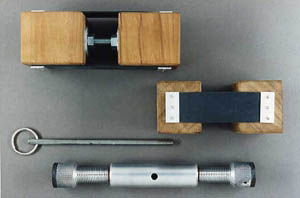
Ruggeri's Coins Réglables and Joanny Visse-Roc René Desmaison.
In the meantime, another French rope, composed of "Southerners" Franck Ruggeri and Didier Ughetto, perfected (in 1962) a set of adjustable chocks for the north face of Corno Stella (Argentera). Of similar design to the Visse-Roc, these jacks were made of hard wood, in five sizes, the largest would lock in a crack 26cm wide.
Primarily these mechanical devices were used to climb very wide cracks. An object of adjustable size would be jammed in a parallel crack of similar width offering an interesting alternative to heavy iron channel pitons or cumbersome wooden chocks and later to the American Bong-Bongs made of Aluminium.

CrackJacks made by Les Wilson & Peter Haan in 1964. 2 originals, made from iron turnbuckles, and one aluminium model. They were used by Peter and Les on the second ascent of the right hand side of the Hourglass in Yosemite.

The Lowe Crack Jumar (photo by Greg Lowe)
In 1967, in the United States, a clever designer contributed a solution to the problem of the parallel crack. The Crack Jumar, conceived by Greg Lowe, was one of the very first artificial protection gizmos using a spring to hold the device on each side of the crack. A primitive instrument, the Crack Jumar remained unique in its field. Greg Lowe and his brother Mike developed their research to consider a different structure, this time exploring the "cam concept".
In 1972, the first prototypes were ready; this spring loaded, single prong camming nut proved very fiddly to place and rather unstable. The future financial stakes however seemed interesting, so on the
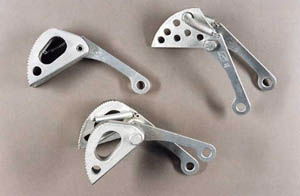
Lowe prototype, Cam Nut and Split Cam, presented by Greg Lowe and Hermann Huber.
16th of August 1973, Greg Lowe took a patent. We find here the constant angle cam concept: "The main body is provided with an accurate cam surface arranged for presenting a constant, intercepting angle with respect to the surface that it abuts". If too small, this angle would not allow the same device to cover a varying range of cracks, while if too large, despite very strong springs, it would slide out at the least
shock. Greg Lowe in his patent, hit also upon the possibility of a device with two opposite cams, hinting at the tools of a near future. One of the first prototypes was entrusted to Royal Robbins for trial. He suggested the name Camel for what was to become the Lowe Cam Nut also known as the Super Nut. Its first commercial advertisement was published in the American magazine Climbing in May 1973 at a retail price of $3,95 (a bargain for this little revolution). Of poor commercial success initially, a more sophisticated version appeared, the Split Cam,made of two cams and two independent arms, which allowed Ed Webster to succeed on the veryphotogenic Super Crack of the Desert (Utah) in 1976.

Very early Lowe Cam Nut advertisement published in Climbing May-June 1973.
During the winter of 1973/74, Ray Jardine, who had worked in computer programming as a space-flight simulation specialist in the late sixties, began his own research in great secrecy. Adhering to a strict discipline, no doubt a side effect of his scientific background, he established an ambitious work diary for his future device: it had to be of a high ratio of strength versus weight. It would be workable with just the one hand, while covering a wide variety of cracks. Well versed in computer science, he conceived the cam shape on a mainframe computer at Colorado University in Boulder. His friend Bill Forrest (Forrest Mountaineering), a manufacturer of climbing equipment, gave him the opportunity of building his prototypes himself in a well equipped workshop. There were many hiccups before the grand result: the first Friend, the first mechanical chock armed with two opposed pairs of independent cam lobes. After many weeks of intense work to improve the stem and the trigger arrangement, a set of three different sizes was ready.
No money "grabbing spirit" motivated Ray Jardine in the creation of this new tool. Himself a very strong climber, he truly wished to forward the limits of high level crack climbing while keeping in mind the free climbing ethic. His invention caused a great deal of controversy later; a fair few detractors would claim that Friends killed the spirit of climbing! Ray Jardine dared to lead, thanks to his new tools, unimaginable free climbing routes and created the first 5.13 in the world, The Phoenix, in 1977. Yet his initial ambition was to make the first "one-day" ascent of The Nose (NIAD) on El Capitan (Yosemite).
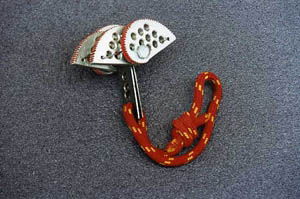
The first Friend (photo by Ray Jardine).
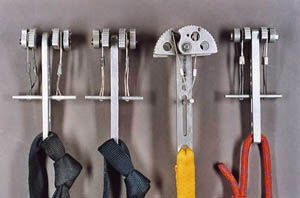
Prototype Friend, early Friends with circlips and with machine nuts.
Feeling that he had broken some extraordinary new ground with his invention, while wanting to protect so many working months, he would only climb with trusted friends. Less than a dozen or so experienced climbers, held by a moral contact with Ray Jardine, would be shown his secret weapons. The mechanical chocks were hidden under the pull-over at the base of the cliff and were "drawn" later well away from prying eyes. One day, at the bottom of the climbs, Kris Walker of Forrest Mountaineering asked Ray: "Did you bring your… ah…" Other climbers present tried to eavesdrop. Kris Walker, embarrassed, uttered: "…friends?" Before this incident, Ray Jardine referred to them as Grabbers, which was a little less romantic. Thus was christened one of the great revolutionary instruments of the twentieth century!
In the summer of 1972 Ray Jardine, who then worked as wilderness instructor for Outward Bound, struck a friendship with a British colleague, Mark Vallance. They climbed together, first in the Boulder area and, later, in Yosemite. By 1975, Mark Vallance, enthralled by the new prototypes, suggested that he manufacture and market them. But it was only in 1977 that Mark Vallance left his job and took up a
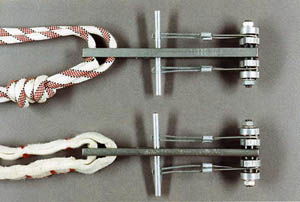
Half-sized Friends with titanium shafts, presented by Hugh Banner.
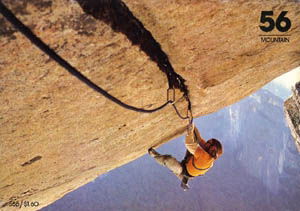
Mountain 56 cover.
partnership with Steve Bean to set up the company Wild Country back in England.
The first advertisement published in Mountain issue 59, in January 1978, was originally drawn by Mark Vallance, which no doubt troubled the readers of this prestigious British magazine. It took over the front cover of Mountain 56 showing Ray Jardine, his hands jammed in a horizontal crack, "walking" under the roof of Separate Reality (5.12). Yet in the Wild Country advertisement, the mysterious protection devices were finally exposed to rather disbelieving climbers. Ray Jardine took out a patent on the 4th June 1977 and distributed the Friends in the United States for a short period under the style of the firm, Jardine Enterprises.
The first units marketed were the sizes of 1, 2 and 3 inches at the price of $17,80 each. Built of aerospace aluminium alloy and of unrivalled strength, they would allow (while respecting certain conditions) to secure the tricky, flared cracks. The two circlips of the original samples were quickly replaced by two bonded jam nuts. In the American magazine Off Belay, Ian Wade wrote in June 1978: "Friends are not cheap" but he explained that, "with twenty-seven separate components and over one-hundred manufacturing operations, never before had a climbing tool reached such level of technology".
If there is anyone in the climbing industry that truly deserves the credit for introducing the "cam concept" to the climbing community, Kris Walker thinks it would most likely be the originators of the Jumar rope ascender, the Swiss mountain guide Adolf Jüsy and the engineer Walter Marti, in 1958. Ray Jardine suggests that cam cleats used on sailboats probably inspired the Jumar.
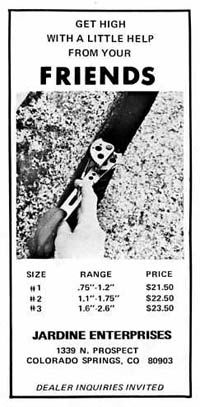
Above: Early Jardine Enterprises advertisement published in Off Belay in August 1978
Right: Very first Friend advertisement published in Mountain January-February 1978.
In 1981, Ray Jardine retired from the forefront of the climbing scene to concentrate, with his usual brilliance, on other disciplines such as sealing, sea kayaking and hiking. Recently he wrote a book on speed hiking on very long distance, The Pacific Crest Trail Hiker's Handbook. It may be that this hand book will change this sport as the Friends revolutionized the free climbing. See also the article a Friend in Need on the Ray Jardine website.
If, in the beginning of the eighties, Friends were the absolute weapon for cracks of a certain size, there were no equivalent tools for the thin parallel cracks. With a stem of 17 mm thick and the cams fully retracted, it was impossible to place a Friend in a crack smaller than 19 mm (finger cracks)!

Sliders, Rock'n Roller, Quickies, Ball Nut, Cobra, Slug, and similar devices.
Another solution to obtain a holding power on the sides of a crack is to introduce two "head to foot" pyramidal wedges in it. Developed by John Stannard and his friends in the Gunks, the system was renewed in the Chouinard catalogue (1977) which showed two inverted Stoppers. For a year and a half, Doug Phillips tried many a combination of opposed wedging chocks before creating his Slider. The first prototypes systematically dropped out, and then
Doug Phillips realized that if in theory the system should work, in practise both wedges do not generate the same coefficient of friction on either side of the crack. He compensated this by pouring some solder, a softer material, on only one of the faces, that in contact with the rock. Doug Phillips took out a patent on the 17th October 1983 and marketed the Sliders the same year by setting up Metolius Mountain Products. Composed of two inverted wedges made of brass, sliding one against the other, held by a dovetail, the Sliders performed well in parallel cracks of granite. Built in five different sizes, the set covered a range of 0,25 to 0,65 inches (0,63 to 1,65 cm). The market, in following years, would witness a plethora of little jewels inspired by the Sliders that could be used in flared cracks.
In 1983, in Germany, Edelrid produced the Amigo, in two sizes, which worked on the same principle of a wedge sliding on another. Designed for medium cracks, 36 to 52 mm, one needed a third hand to place them, that brushed aside quite a number of potential users living on our planet. A year later, the same German company produced the Bivos. Invented by Bernt Prause, this mechanical chock
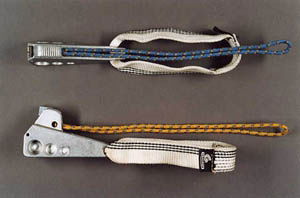
Edelrid Amigos.
maintained the rigid stem of the Friend while only two cams rotated on the top of the stem. A rigid trigger mechanism locked the cams together, thus loosing all independence. A second generation of Bivos rectified this major fault. With quite a narrow head, this mechanical chock was well suited to shallow cracks.
Another rival to the Friend was conceived by the very creative David Oldridge in

Edelrid Bivos 1st and 2nd generation
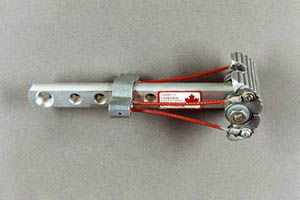
Canadian Quest Technology Buddie, presented by Mark Vallance
1982. An Englishman who emigrated to Canada, he founded Canadian Quest Technology around his brain child, the Buddie. In spite of a great deal of advertising, this remake of a manual razor did not reach the road to success. A mechanical chock with two opposed cams made of moulded aluminium, its design allowed it to be used as a passive chock, the cams could not be reversed, but it was unreliable in downward-outward flare cracks, very much the favoured territory of the Friend!
The patent taken out by Ray Jardine covered the trigger mechanism involving the rigid stem and the trigger bar. The use of constant angle cam could not be recognised as a new invention. Any potential rivals would have to research another design of handle so as not to infringe upon on the patent of the Friend. While engaged in technical studies in a college of Oregon, a young climber, Steve Byrne, was to create a small wonder. In 1982, a mate of his claimed, if he would be able to build a camming device of a half inch width, they would sell in Yosemite like hot cakes. A first batch of fifty of these miniatures, mounted by a rigid stem of steel, was brought to Yosemite by the legendary Oregon climber Alan Watts and all too soon were sold out.
These "half-Friends" were smaller than anything available on the US market then, as camming devices. At this time, Steve Byrne was helping Doug Phillips (Metolius) with the manufacturing of the Sliders, getting accustomed to the delicate silver soldering process. During the winter of 83/84, the need for another innovative product was necessary at Metolius.
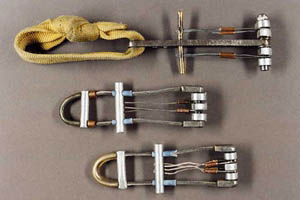
Steve Byrne ½ inch "Friend", Wired Bliss prototype TCUs, presented by Steve Byrne.
Clearly the main problem with the small cams was that the stem was stiff. Such a rigid stem inhibited placement in all but the most perfect cracks. One Sunday, Doug Phillips tried to figure out how to solve this problem. He essentially took one of the small cams that Steve had made and replaced the rigid stem with a flexible cable (it was a bit of a cable that he had rejected for use in the Slider ), and created a rather crude flexible four cam unit. After showing this "prototype" to Steve Byrne, the two came to an agreement that this cam needed a head width much smaller. So the next model made by Doug Phillips had three cams, but still used a single flexible stem. The wire was connected to the axle with a yoke fitting; the center cam in the middle of the yoke, and the outer cams on each side.
But the ultimate piece in the puzzle came from Steve Byrne. Suddenly, inspiration caught him; he built a U-shaped flexible body made of a cable to be attached to the two ends of the axle. Then a star was born!
The TCU or Three Cam Unit, very narrow, would home in shallow cracks, while its flexible wire frame would allow it to be used in horizontal cracks. It was a major step forward. In 1985, Steve Byrne moved to Flagstaff (Arizona) and started his company, Wired Bliss. By this time Doug Phillips also decided to produce the TCU . Offered in five sizes, the TCU seemed to have come straight out of a clockmakers workshop and could be used in cracks of 0,4 to 1,4 inches.

Wired Bliss TCUs and very rare Narrow TCUs
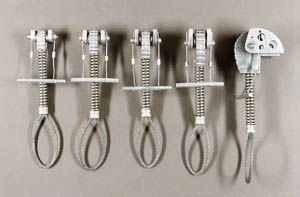
>Bergsport Jokers.
With the Joker, invented in 1985 by Stefan Engers, the German company Bergsport made a marked entry in the world of the mechanical chock. With only two mobile cams and a simple loop of cable stiffened by a coiled spring, this new comer had the advantage of a flexible handle to adapt to all positions.
A legendary figure in British climbing, the graduate electrical engineer Hugh Banner,
was already specialising himself in the making of micro nuts made of silicon bronze in the early eighties. In 1982, during a bivouac at Camp 6 on The Nose, Mark Vallance asked him to make his Offsets for Wild Country. Mastering the silver soldering process, Hugh Banner began to work on a camming device. In the beginning, it was an English replica of the TCU of Wired Bliss, yet he advantageously changed the trigger
mechanism by a single ring pull workable with just one finger. The device, becoming narrower, would home deeper in the cracks and was easier to retrieve. Hugh Banner took out a patent on the 5th August 1987 and his Micromates, the first TCUs in England, were marketed by Clog, then owned by Wild Country. Very well and carefully made, they rightly completed the range of Friends.
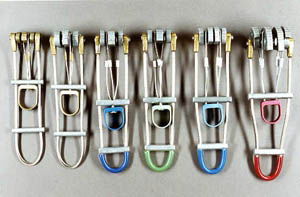
HB prototypes, Micromates and Quadcams, presented by Hugh Banner.
Hugh Banner, wanting his own independence, set up HB Climbing Equipment in Wales in 1988. To fill up his catalogue, he took up the concept of the U-shape, flexible wire frame for a camming device with four cams, the Quadcam, first protection of its style. Oddly, HB used silicon bronze for the cams of the smallest size of the Micromates and the Quadcams. Hugh Banner did not stop there; soon he would use his knowledge of the hot forging process for a new mechanical chock with a rigid stem: the Fix. The stem of the original Friends was made from aluminium alloy extruded rod. Hot forging
ensures that the grain structure of the metal is compact and correctly oriented. The HB Fix, marketed in 1990, had a strong, hot forged stem, yet not to infringe on Ray Jardine's patent, the trigger assembly was completely redesigned. Two separate triggers operated each a pair of cams, a system that HB protected by taking out a patent on the 3rd January 1991. Now 73 years old and a true mine of scientific knowledge on the nuts' story, Hugh Banner today runs his business with his wife Maureen, with great dynamism*. ( * they retired in 2004 )

HB Fixes.
A climber from Durango, (Colorado), convinced that the safest protection requires a minimum of four cams, began to think about it. In 1986, David Waggoner started Colorado Custom Hardware with the production of the Trigger Cams. Small squat camming devices with a stainless steel rigid stem, they owed their narrowness to an astuteness foreseeing the future creations of their designer: the springs that
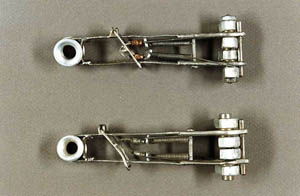
CCH Trigger Cams, presented by Dave Waggoner
loaded the cams had merged between the two sides of the rigid frame. Later, David Waggoner invented the Cable Pro and created what he was to call "The Stainless Steel Control Sheath" on which he took a patent on the 11th August 1987. A sheath of plated steel thread allowed the device to operate whatever the bending of the flexible stem and to place and to retrieve the Cable Pro in the most awkward slots. The sheath also protected the main cable from

CCH Cable Pros and
Alien III
abrasion. Yet David Waggoner's true stroke of genius was completed by inserting the springs within each of the cams, finally realizing the narrowest four cam unit in the world! He took out a patent on his latest invention on the 2nd of December 1988. A combination of these two brilliant ideas would later create the Alien, a sophisticated device in which it is difficult to recognize the primitive Trigger Cam.
Graduated, with a Ph. D. degree in Mechanical and Human Factors Engineering from UCLA (University of
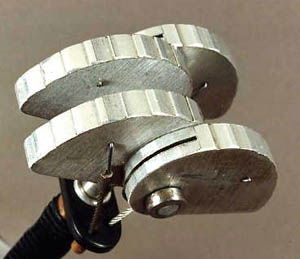
CCH Alien
California in Los Angeles) and an inventor by profession, Tony Christianson specialized in the design of life support systems for diving and climbing. A few years ago, he met Yvon Chouinard, then owner of the famous Californian company Chouinard Equipment (today Black Diamond) when he tried to interest him in an exercise device he had invented. Chouinard politely declined his offer but expressed an interest in any idea he might have for camming protection. Chouinard Equipment had

Prototype Camalot (photo by Tony Christianson).
to complete its arsenal with a performing camming device. Tony Christianson returned to his drawing board and it took months of thought and many false starts before there was some light at the end of the tunnel: using two parallel axles instead of one does appreciably increase the expansion range of the device. When Tony Christianson went back to Chouinard Equipment with his prototype, the welcome was a great deal warmer. One nearly brought out the champagne and the petits fours.
At Chouinard, things are not done lightly; hence many prototypes were tested in and outdoors, thus delaying the launch onto the market of this new candidate to the five continents' cracks. Tony Christianson protected his invention by taking out a patent on the 26th of September 1985.
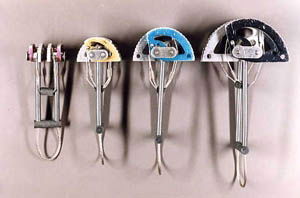
Chouinard Camalots 1st generation.
To the two springs guided by the legs of the U-shaped body of his prototype, the engineers Julio Varela and Honk Kyu Kwak found that the best cam action was achieved by individually loading the cams with torsion springs. With a name resulting from many suggestions by employees at Chouinard Equipment, the Camalot was marketed in September 1987, sixteen years after the first Hexentrics.
If the wider cracks had always intimidated climbers, it was more due to the lack of appropriate protection devices than by cowardice, the early tools available on the market being awkward. The various models available later were replicas in growth of the Friends, homemade and more or less
reliable. The first manufacturer to think about it seriously was C.C.H. who produced the Seismo in 1986, illegitimate child of the Friend and the Visse-Roc. With two cams opposed to an adjusting crossbar, it was possible to increase the range of this device by three extensions made in two, three and four inch lengths and usable in any combination. This disquieting object has fallen into oblivion.
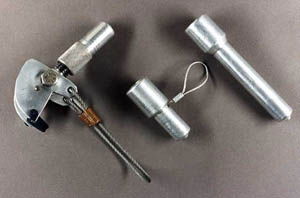
CCH Seismo, presented by Dave Waggoner.
In 1984, Craig Luebben, guru of the offwidths, designed a new concept of protection device for his senior honors thesis in mechanical engineering at Colorado State University, in Fort Collins. After
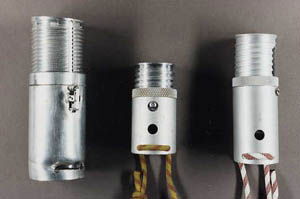
Craig Luebben prototype Bigbro, Mountain Hardwear Bigbros, 1st and 2nd generation.
seven rough prototypes, his Bigbro was operational. Built of two tubes sliding within each other, the Bigbro owes its expansion to a powerful inner spring. It can be placed with one hand and is more specifically applicable to parallel cracks. With a name straight out that great classic book 1984 by George Orwell, "Big Brother is watching you", the size 4 Bigbro at 30,5 cm long, is probably the biggest mechanical chock in the world.
In the States in 1987, John Yates (Yates Gear), and later in Spain, Jaume Aregall (Fixe) marketed giant units that would allow a sensible approach to toughest and most forbidding slots. Both manufacturers have adopted the now well established four cam configuration for their devices. In size 5, 6 and 7 inches, the Yates Big Dudes favoured a U-shaped flexible stem. John Yates also made a few samples Big Dudes in 9 inches for fun.
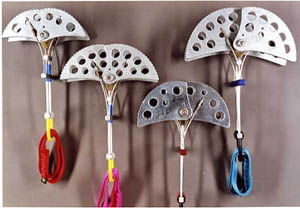
Yates Gear Big Dudes. One sample is signed "John Yates".
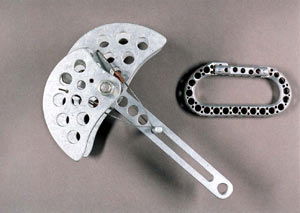
>Above: Buddie #5, made by Steve Byrne (Wired Bliss), presented by Rick Donnelly.
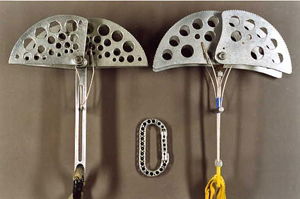
Above: Home made #9 cam by John Fowler, Tucson, Arizona and (right) Yates Gear Big Dude #9.
With a set of seven different sizes, the Fixe Companys (Friends in Catalan) reused the rigid stem of the original Friends, the greatest size covering a crack of 27,5 cm. There is even a collector's sample that covers… 35 cm!

Fixe
Companys
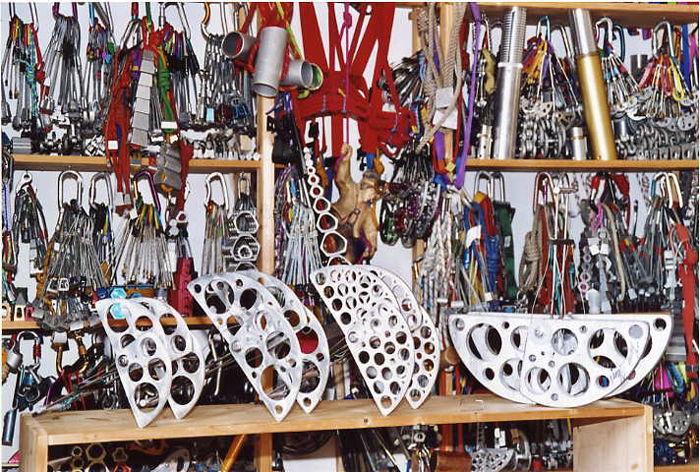
Gear from the Nuts Museum including Giant Cams (from left to right):
Tom Kasper New-Generation Valley Giant #9 and #12 (2003),
Old -School Valley Giant #12 (made of magnesium) (2002) and Wally Cam #16!
Far from being exhaustive, this retrospective needs to remember another item "made in USA" in the eighties. Invented by Peter Taylor, the Coyote Mountain Works Samson was probably the only spring loaded camming device almost exclusively made of composite, (long fiber glass, carbon, nylon). While being extremely light and covering a wide expansion range, the Samsons were short lived, as climbers resigned this noble compound to skills lesser than climbing, such as… dominos or tennis!
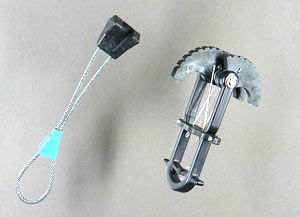
Coyote Mountain Works
Coyote Nut # 4
& Samson Cam # 4 .
What is in store for us in the third millennium? There may well be some budding Ray Jardine who is working in great secrecy on the future "Slab-Kiss" to allow the conquest of blanker mirrors, "boltless", while emancipating oneself of Rambo's drill…
Yet my "friends", that's another story.
Nuts' Story: Clockwork Friends was first published High Mountain Sports No.251, October 2003 under the title Nuts' Story: Adjustable Expanding Protection.
It was translated from the French by Paul Cartwright and John Brailsford.
Back to
Nuts Museum.